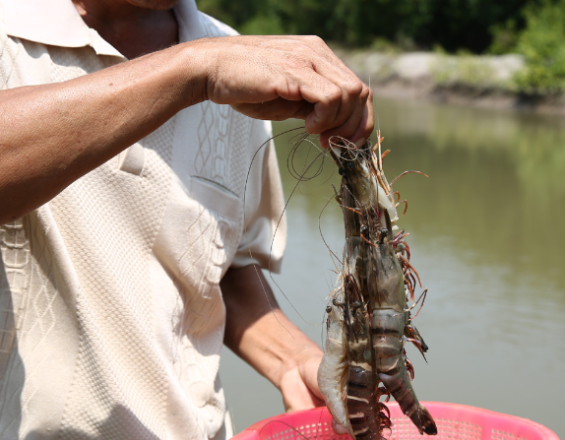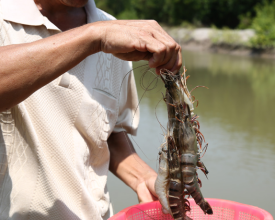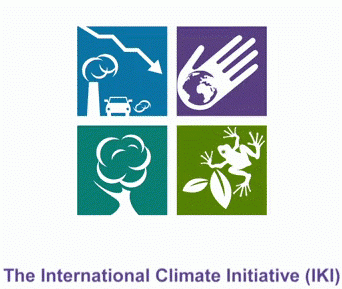
Horizontes camaroneros: cómo los criadores de camarones están salvando miles de hectáreas de manglares en Vietnam

En las últimas tres décadas, Viet Nam ha perdido la mayor parte de sus manglares, principalmente debido a la expansión de la cría de camarones, uno de los principales contribuyentes a su economía.
Para ayudar al gobierno vietnamita a abordar el problema, la UICN y la ONG holandesa SNV Netherlands Development Organisation pusieron en marcha el proyecto Manglares y Mercados (financiado por la Iniciativa Internacional sobre el Clima) en Cà Mau, para ayudar a los criadores de camarones a obtener la certificación orgánica de Naturland, EU Organic y otras etiquetas orgánicas.
Las certificaciones exigen al menos un 50% de cobertura de manglares por explotación. Los criadores pueden vender gambas certificadas a la Minh Phu Seafood Corporation a un precio superior. El proyecto también ayudó a Cà Mau a poner a prueba un sistema y una política de Pago por Servicios Ecosistémicos, que obliga a las empresas marisqueras a pagar a los agricultores un incentivo de 500.000 VND (17,77 £) por hectárea para la conservación y restauración de los manglares por proporcionar servicios ecosistémicos.
El éxito del proyecto ha llevado a reproducirlo en las provincias de Ben Tre y Tra Vinh.
Contexto
Défis à relever
- En las últimas décadas, Vietnam ha perdido la mayor parte de sus manglares, principalmente debido a la expansión de la cría de camarones, uno de los principales contribuyentes a su economía.
- La pérdida de manglares es problemática, ya que unos manglares sanos contribuyen de forma importante tanto a la adaptación al cambio climático como a su mitigación.
- La pérdida de ecosistemas de manglar también significa menos hábitat natural para especies acuáticas y terrestres, y menos opciones de sustento para las comunidades locales.
Ubicación
Procesar
Resumen del proceso
En este proyecto concreto, la certificación orgánica permite proteger y restaurar los manglares y obtener un precio superior por las capturas, gracias a la participación de Minh Phu Seafood Corporation en el proyecto.
La clave está en ofrecer incentivos. Los criadores de gambas tienen un incentivo para conservar y restaurar los manglares y obtener la certificación ecológica, y Minh Phu Seafood Corporation puede exportar las gambas ecológicas al mercado europeo, ampliando así su alcance comercial.
El proyecto también ayudó con éxito a Cà Mau a poner a prueba un sistema de Pago por Servicios Ecosistémicos (PSE). Este sistema proporciona a los agricultores un incentivo adicional para la conservación y restauración de los manglares, pagándoles 500.000 VND (17,77 £) adicionales por hectárea de manglar por proporcionar servicios ecosistémicos.
Para que una iniciativa de este tipo tenga éxito, es importante que se imparta formación a la mayoría de las partes implicadas, incluidos los agricultores y las empresas de transformación de gambas.
Para este proyecto, Minh Phu también invirtió en su propio equipo del Sistema de Control Interno, una cadena de suministro desde la granja hasta la fábrica, e incentivos financieros para los recolectores, estaciones de recolección y pagos para apoyar al FMB con el seguimiento.
Bloques de construcción
Educación y formación de agricultores en certificación ecológica de gambas
Para obtener la certificación ecológica, los agricultores necesitan formación sobre la instalación y el uso de retretes con fosas sépticas y la gestión de los residuos domésticos. También es necesario cofinanciar el suministro de kits de retretes y la replantación de manglares en los estanques de camarones durante una demostración piloto.
No solo hay que formar a los agricultores, sino también a los protectores forestales sobre las nuevas tecnologías aplicables para la gestión y protección de los manglares, con el fin de supervisar y auditar la cubierta de manglares contratada. Entre 2013 y 2017, el proyecto organizó formaciones periódicas para ayudar a transformar el sistema de gestión forestal de las Juntas de Gestión Forestal, que pasó de basarse en mapas catastrales dibujados manualmente y mediciones sobre el terreno a basarse en mapas digitales, utilizando sistemas de teledetección, SIG y medición y seguimiento por GPS.
El proyecto también debe proporcionar a las empresas transformadoras de gambas formación para establecer y mantener equipos de Sistemas de Control Interno. Esta formación ayuda a las empresas a establecer auditores de agricultura ecológica y equipos de supervisión propios. Estos equipos son necesarios para apoyar y supervisar a los agricultores ecológicos en amplias zonas para que cumplan la norma de certificación ecológica.
Factores facilitadores
- Inversión financiera en educación y recursos educativos.
- Conocimientos científicos y técnicos para desarrollar programas de educación para la certificación.
- Incentivos para que los agricultores reciban formación y certificación.
- Apoyo de la administración local, especialmente del sector forestal, para organizar gran parte de la formación.
Lección aprendida
- La formación no debe ser puntual, sino una serie de cursos de formación y reciclaje cada año. La concienciación de los agricultores debe ser gradual.
- Convencer a los agricultores para que participen en la formación inicial es lo más difícil, ya que a menudo tienen dificultades para entender la idea de la agricultura ecológica, y algunos de los cambios necesarios en las prácticas agrícolas van en contra de sus conocimientos comunes.
- El apoyo de las autoridades locales, especialmente de los consejos de gestión forestal, es crucial.
Incentivos para conservar y restaurar los manglares mediante la certificación ecológica del camarón
La norma Naturland exige que cada explotación tenga al menos un 50% de manglares, mientras que otras normas orgánicas exigen un estricto cumplimiento de la política forestal. Los granjeros que demuestren su cumplimiento podrán vender sus gambas certificadas a Minh Phu Seafood Corporation, el mayor exportador de gambas de Vietnam.
El proyecto también ayudó con éxito a Cà Mau a poner a prueba un sistema de Pago por Servicios Ecosistémicos (PSE). Este sistema incentiva la conservación y restauración de los manglares pagando a los agricultores 500.000 VND (17,77 libras esterlinas) adicionales por hectárea de manglar por prestar servicios ecosistémicos.
Además de los pagos a los agricultores, Minh Phu también invirtió en su propio equipo de ICS, una cadena de suministro de la granja a la fábrica e incentivos financieros para los recolectores, estaciones de recolección y pagos para apoyar al FMB con el seguimiento.
En este sistema de PSE, el procesador paga a los agricultores por los bienes y servicios ecosistémicos que proporcionan, y la cobertura de los manglares es supervisada por un tercero. Este planteamiento de pago directo ha sido aceptado por el Ministerio de Agricultura y Desarrollo Rural.
El proyecto también ha animado a otras empresas transformadoras a establecer su zona de agricultura ecológica con diferentes sistemas de pago, entre ellas Seanamico, Seaprimexco en Ca Mau.
Factores facilitadores
- Existencia de normas internacionales de certificación
- Demanda del mercado de productos certificados
- Colaboración multisectorial
- Inversión y financiación
- Experiencia en conceptos de PSE
- Apoyo político del gobierno local
- Apoyo técnico y financiero de otros proyectos de la UICN y SNV para colmar algunas lagunas del proyecto.
- Compromiso de Minh Phu seafood Corp sin facturación inicial del camarón ecológico
Lección aprendida
- Un Pago por Servicios Ecosistémicos (PSE) funciona cuando el procesador y, en última instancia, el consumidor internacional de gambas ecológicas son los compradores de los servicios ecosistémicos. Los propios agricultores no pueden ser los compradores de los servicios, ya que serían a la vez compradores y vendedores de los mismos servicios;
- Un PSE basado en la certificación ecológica con un sistema de pago directo entre el transformador de gambas y el agricultor y un auditor independiente es más eficiente que un sistema alternativo de pago indirecto propuesto en el que los transformadores de gambas pagan a un fondo de desarrollo forestal;
- Aunque los cálculos científicos han demostrado que el valor del PSE de los manglares es 10 veces superior a la cantidad que se paga actualmente al agricultor, el incentivo real debe fijarse al nivel que sea viable para el transformador de marisco y el consumidor. Esto se equilibra con el incentivo basado en los beneficios para que el agricultor mantenga la cubierta forestal.
- La distribución de los incentivos debe ser clara y transparente, y estar cuidadosamente supervisada, por lo que la participación del gobierno local es fundamental.
Impactos
Al final de la primera fase del proyecto, más de 2.000 camaroneros habían recibido formación en producción ecológica certificada de camarones. De ellos, más de 1.000, que gestionaban 7.000 hectáreas de manglar-camarón integrado, habían firmado contratos para mantener una cubierta de manglar del 50% y más de 500 habían obtenido la certificación ecológica de Naturland.
La primera fase del proyecto fue premiada por el gobierno de Cà Mau por ayudar a la provincia a alcanzar sus objetivos socioeconómicos y medioambientales.
El proyecto también está apoyando al Comité Popular Provincial de Cà Mau para poner a prueba la Decisión 111 para regular los proyectos de camarones orgánicos en la provincia. Esta decisión se emitió en 2016 y está siendo supervisada por la Administración Forestal de Vietnam como modelo piloto de Pagos directos por Servicios Ecosistémicos para la acuicultura.
Hasta junio de 2018, el proyecto ha formado a más de 5.000 agricultores. El proyecto también ha contribuido a la replantación de 80 hectáreas de manglar y a la protección de 12 600 hectáreas de manglar.
Beneficiarios
Fase 1
- Agricultores y comunidad de Cà Mau
- Empresa exportadora de camarones Minh Phu
- Capacitación de las autoridades locales;
Fase 2
- Agricultores y comunidad de las provincias de Ben Tre y Tra Vinh
- Cuu Long Seafood Corporation
- Desarrollo de las capacidades de las autoridades locales
Objetivos de Desarrollo Sostenible
Historia
Citas de agricultores
"La Junta de Gestión Forestal (FMD) diseña planes de replantación de manglares en las granjas camaroneras y suministra los plantones. En los bosques de producción, al cabo de 15-18 años, los árboles han madurado lo suficiente y la gente puede obtener el 80-90% de los beneficios", afirma el camaronero Văn Công Tỏ. "La superficie forestal de mis tierras sigue siendo inferior a la necesaria (60%). Muchos camarones murieron de enfermedades, sobre todo en las tierras no protegidas por manglares. Pude ver entonces que el bosque es muy útil para criar camarones."
"Todos los criadores opinan y discuten con sus vecinos, y luego ponen en práctica lo aprendido en sus propias granjas", afirma el jefe del grupo de criadores de gambas Trần Quốc Văn. "Para nosotros ha sido un verdadero éxito. El aumento de la productividad, el rendimiento y los ingresos gracias a la adhesión al proyecto de certificación significa que podemos vender nuestro producto un 10% más caro que el camarón no ecológico. Antes, los criadores podían ganar 60-70 millones de VND al año, y ahora podemos ganar 150-200 millones de VND al año tras unirnos a este proyecto."

